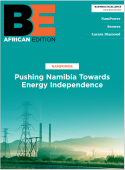To boldly goÔǪMark Kolebaba explains to Gay Sutton how Diamonds North is doing things differently, not so much to lead the field, but to accelerate the diamond exploration process and stay ahead of the competition. The cold Northwest Territories of Canada are inhospitable, dark and icy for several months of the year, and yet they are potentially rich in quality diamonds that rank among the best in the world. The mines already operating there can yield gems priced at anything from $150 to $300 per carat, whereas diamonds from South Africa, for example, will earn around $86 per carat. The existing Canadian mines are also productive. Ekati, which belongs to BHP Billiton, produces one carat per tonne (metric ton) and Rio TintoÔÇÖs Diavik is even more productive at over three carats per tonne. Many other locations around the world produce less than one carat per tonne. So for the bold and dedicated, there is a lot to play for in Canada.ÔÇ£Diamond exploration is a high-risk business. But what makes it exciting is the reward. If you do make a discovery, the reward will be absolutely fantastic.ÔÇØ explains Diamonds NorthÔÇÖs president and CEO, Mark Kolebaba. A successful discovery could earn around $20 billion, but the investment required for exploration is huge. ÔÇ£We have no revenues, so all our financing comes from high-risk investment dollars. The investors know the risks and are enticed by the possible rewards. But the people investing in us now are somewhat different from those of just four or five years ago, because the projects are becoming more mature. The reward is starting to look better than the risk.ÔÇØDiamonds North is a junior mining company founded in 2002 with just three employees and the express aim of exploring for diamonds. Six years later, the company has 15 permanent staff and around 70 seasonal employees who work on the ground between March and the end of September while weather and light permit. The company has already discovered diamond-bearing kimberlite, and it has done so in just six years by employing a series of bold and unconventional moves, combined with the use of new technology, to accelerate the rate of exploration.ÔÇ£What we did was very different. We started off with one project of about 1 million acres,ÔÇØ Kolebaba explains. But unlike any other junior mining company that he has heard of, Diamonds North made the decision to expand its operations and undertake a number of projects simultaneously, ÔÇ£giving us a better opportunity of finding the next diamond mine,ÔÇØ he continues. ÔÇ£So we explored over 300 million acres in the north, and out of that we acquired 27 million acres. That made us the second-largest landholder in Canada, the first being De Beers.ÔÇØKolebaba is a great believer in experimenting and developing new technology. ÔÇ£Once we had acquired the ground, we took a very rapid and systematic approach to exploring. The team we created has the ability to be comfortable with trying new techniques. Sometimes weÔÇÖve been wrong, but weÔÇÖve been very successful in coming up with new techniques that make exploration cheaper and faster.ÔÇØWhere most of its competitors use traditional geophysical techniques to collect data and analyze the rock composition on their land, Diamonds North identified new airborne systems that could provide better data at higher sensitivity. ÔÇ£Where a commercial surveyor may give you 10 readings per second, the system weÔÇÖre using gives you 500 readings per second. We fly that equipment and use it religiously, and itÔÇÖs given us a huge ability to find more targets.ÔÇØHaving identified the most promising areas of land, the next step in exploration is to test drill and look for kimberlite, the rock in which diamonds are found. The company has looked far and wide for technology to speed this up. ÔÇ£In diamond exploration you learn very early on never to use percussion, because percussion hammering will break diamonds, and itÔÇÖs very destructive. In gold mining, however, hammering is not a problem because gold is malleable. We had a project up in the north that had 500 targets. To do all thisÔÇöusing a conventional core drill at $150,000 a drill hole and taking three to four days per drill holeÔÇöwould probably have taken us six to seven years to complete at a cost of about $10 million.ÔÇØ The answer Diamonds North identified went against all the conventional wisdom of the industry, but it worked extremely well. ÔÇ£We found a percussion drill that was never used in diamond exploration. Although it could potentially destroy diamonds, we needed that speed to find kimberlite. Now, once weÔÇÖve found kimberlite we can drill with a conventional core rig.ÔÇØ This process is about six times faster and five times cheaper than the traditional drilling method, and it has enabled the company to drill 60 targets in a year rather than five or ten.Exploration so far has narrowed down the original 27 million acres of land to less than 8 million, and Diamonds North is now involved in three key projects, Amaruk, Hepburn and Banks Island. ÔÇ£The most advanced is Amaruk, where weÔÇÖve discovered 25 kimberlites, and that number may change shortly. We have also taken bulk samples from two areas that have demonstrated quite high diamond contentÔÇöa 20-tonne and a 15-tonne from Tuktu and QavvikÔÇöto see if they have commercial-sized stones,ÔÇØ Kolebaba says. What they are looking for are large gemstones rather than small industrial stones, and he points out that there can be no more than two or three projects worldwide that have reached this stage of development.During the course of the exploration the company has also identified 3ÔÇô4 million acres of land with uranium potential and a nickel prospect at its Amaruk site. Diamonds North is determined to capture value from all resource potential associated with its large land package. However, it intends to remain focused on diamond exploration and to do what it does best. ÔÇ£The team that we have is also taking the long-term approach,ÔÇØ Kolebaba says. ÔÇ£Where people are jumping from one company to the next looking for the highest pay, we have the same employees that we had on day one, and thatÔÇÖs rare in this business. We want to make a discovery in diamonds; thatÔÇÖs what itÔÇÖs all about.ÔÇØTimes must be pretty tense in Vancouver as team members wind down their field operations for the winter and await results from the lab to indicate whether they have achieved their aim or will be continuing the search in six monthsÔÇÖ time for CanadaÔÇÖs next big diamond mine.┬á









